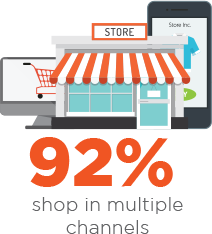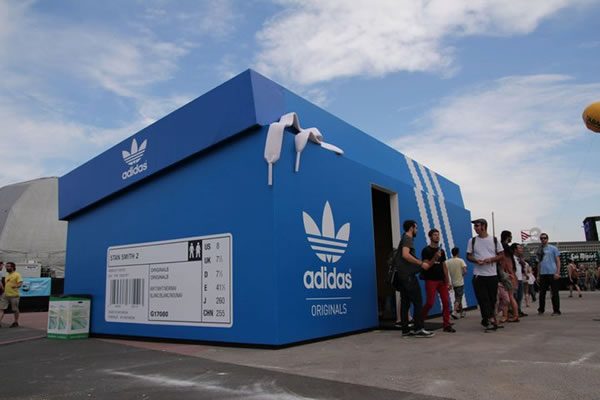Bricks & Mortar is dead. Long Live Bricks & Mortar!
We’ve all heard about (but have even recently witnessed ourselves) the impact of e-Commerce on traditional bricks & mortar businesses. With both Tesco Direct, & Mark’s and Spencers announcing closures this month, a lot of the reason’s cited are exactly why e-Commerce has been so strong for so long. From cheaper running costs (with physical leasing, inventory management and building logistics being a costly & complex matter) to ever fickle customers always sniffing out the cheapest deal, meaning often, those physical shops were left empty, to online services generally being more accessible and hey, everyones got the Internet right?
With the demise of physical retail we’ve seen high streets transformed from bustling areas of shopping and commerce to great swathes of abandoned retail units with mail piling up at their un-opened doors. Look in any town or any shopping precinct and you’ll find them. The street looking like something out of 28 Days Later.
You’d be right to think e-Commerce killed the high street a long time ago. In fact, I even wrote about this a couple of years ago on my blog here. And we all know the impact Amazon have had on traditional retail. However…
Things they are a changing.
In an ever-noisy and extremely saturated online world with ad buying becoming an invariable lottery (especially for those not doing it programmatically, and for those who do, I wrote about my foray into Google’s Double Click for NEXT here to show some of the benefits of that ) especially when in battles with the likes of Amazon, customers are looking for that key differentiator to give their brand loyalty to.  We’ve known for some time those companies with a high street presence are often felt as being ‘safer’ and ‘more established’ but certainly in bigger e-Commerce verticals the presence of a bricks & mortar branch really could help push e-Commerce sales and more importantly increase the quality of the sales therein & customer satisfaction. Customers are demanding that ‘omni-channel’ sales experience, so sure they buy that widget online, but when it gets delivered, and it develops a fault, they often want to take it into a store and deal with a human being.
We’ve known for some time those companies with a high street presence are often felt as being ‘safer’ and ‘more established’ but certainly in bigger e-Commerce verticals the presence of a bricks & mortar branch really could help push e-Commerce sales and more importantly increase the quality of the sales therein & customer satisfaction. Customers are demanding that ‘omni-channel’ sales experience, so sure they buy that widget online, but when it gets delivered, and it develops a fault, they often want to take it into a store and deal with a human being.
An excerpt from the Guardian;
Macy’s and Nordstrom, for example, spent an estimated $6.4m and $4m, respectively, in paid search listings for the top 1,000 apparel-related keywords in the first quarter of 2015, according to a study this month from L2 Inc, a research firm that tracks digital brands. Clicks disproportionately go to the highest-placed search ads, with little room for differentiation,” states the L2 report, which examines what it calls “evolved retailers” – online merchants that have opened brick and mortar storefronts.
By opening physical stores, they aim to increase awareness and draw customers in a realm where the retail options aren’t infinite or influenced by an all-powerful gatekeeper. And for purveyors of tactile and personal products like clothing, eyewear and jewellery, selling stuff in person has an obvious appeal.
The more complex the product you are selling, the more customers will appreciate & use a physical branch, (or shop or store) to get follow up information, support & guidance. For many, the success of pop up stores have helped quick expansion for start ups, but also Amazon are putting considerable cash into their automated stores and it only serves to give the customer a better purchasing experience which in turn, fuels revenue growth.

https://www.theguardian.com/business/2016/jan/30/future-of-e-commerce-bricks-and-mortar
I guess one of the questions I ask is at what point does maintaining or building a physical store presence actually become part of an e-Commerce revenue growth plan, and no longer will sinking advertising dollar into PPC campaigns or paid media actually be sufficient?
I’m not suggesting that all the work done by companies to cut their stores and fire staff, close down branches or re-locate into cheaper areas is work wasted, but what I am seeing is that the companies with efficient slick and lean physical branch networks which can integrate seamlessly into their online offering, that’s where key growth can lie. That experience has to be seamless, and companies like Apple go some way into getting it right, with John Lewis being another example of strong inter-links between it’s physical stores & it’s online shop.
I’ve worked for two large brands who had seriously extensive presence on the high street. I watched those same companies (and was also heavily involved) in the closing of those branches, the re-structuring of those branches & the letting go of staff. All because of a shiny new website cited to make the shareholders more revenue, more profit & everyone’s a winner right?. Was this too much too quick with little thought into whether e-Commerce would be the answer to all our prayers? And was the notion of flagship stores (as opposed to mass regional presence) ignored or mis-understood, as companies hastily chopped their branch networks with focus on cost saving only?
“The big benefit of the flagship stores is that they’re terrific marketing vehicles,” said Jason Goldberg, senior vice-president of commerce and content at digital agency Razorfish. “Not only do those stores tend to be economically successful on their own but they generate a huge lift in incremental shopping to the online store.” That’s been the case for Warby Parker, which has created a popular brand by selling stylish eyeglass frames for under $100. After starting online in 2010, it opened its Soho flagship three years later and now has 20 stores nationwide, with plans to add another 20 this year.
So you can see part of a potential e-Commerce growth plan can often be a pop up shop. Certainley if you’re selling tee-shirts or mugs, or shoes, or glasses then it suits this perfectly. But what if you’re selling something larger or more complex, like electrical products or products for the trade? Sites such as appearhere offer ad-hoc space renting for companies who want to extend their presence across channels, whilst keeping costs managed. As a Marketing Dept. why can’t this be just an effective solution to sales increase alongside an online sales campaign or more PPC budget?
My advice to Marketing Depts.
Start to consider (if not already) using customer demographic, footfall and other retail ‘big data’ to understand whether the feasibility of a branch network or pop up store for your client is suitable and could enhance their sales. Consider how CRO works and how to really understand it (a blog post I wrote about this very subject here) Use this data to make smart decisions about whether stores should be closed, moved or left alone. Don’t have the skills? Get someone in. Retail planning specialists such as linney.com who visualise stores to allow retailers to make improvements, to bringing in digital technology to augment the physical sale using technology such as NFC (yes I’ve been involved in that too! Putting NFC into screens and all kinds of stuff) are really good companies to leverage. What they’ve done for the likes of Boots, Argos & The Home Retail Group are astounding.
If you’re ad buying ensure you’re considering doing it programmatically to really leverage the tempo of your clients customers, to ensure it’s effective & timely.

My advice to companies
Really think carefully about whether your online e-Commerce facility really is your magic bullet. Would the presence of stores or branches (be they pop up or existing) help to assist sales, support customers or extend brand awareness? If so, are these stores working hard enough. Are you using big data to understand how customers are using your stores & whether a small change here or there would have a dramatic impact? Concerned about merchandising efficiencies, start to consider (and invest) in technologies such as automated artworking, to which I’ve seen first-hand considerable cost savings because of the slick implementation of this very clever technology.
My Summary
I’ve started to see the re-value of physical branch presence, and if they are treated with care and love, they can be a real asset, a great selling tool and help to enhance the brand. What has negative impact is stores which are badly integrated, communicated to, haven’t been on the digital transformational journey or those which are so far removed from what’s happening at head office, they are little enclaves of misbehaviour often not working hard enough for the brand. For more about digital transformation see my post here.




